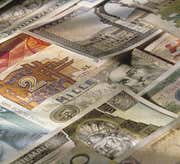The price/earnings ratio (P/E) is the best known of the investment valuation indicators. The P/E ratio has its imperfections, but it is nevertheless the most widely reported and used valuation by investment professionals and the investing public. The financial reporting of both companies and investment research services use a basic earnings per share (EPS) figure divided into the current stock price to calculate the P/E multiple (i.e. how many times a stock is trading (its price) per each dollar of EPS).
It's not surprising that estimated EPS figures are often very optimistic during bull markets, while reflecting pessimism during bear markets. Also, as a matter of historical record, it's no secret that the accuracy of stock analyst earnings estimates should be looked at skeptically by investors. Nevertheless, analyst estimates and opinions based on forward-looking projections of a company's earnings do play a role in Wall Street's stock-pricing considerations.
Historically, the average P/E ratio for the broad market has been around 15, although it can fluctuate significantly depending on economic and market conditions. The ratio will also vary widely among different companies and industries.
Formula:
Components:
The dollar amount in the numerator is the closing stock price for the fictitious Zinzibar Holdings as of December 31, 2017 as reported in the financial press or over the Internet in online quotes. In the denominator, the EPS figure is calculated by dividing the company's reported net earnings (income statement) by the weighted average number of common shares outstanding (income statement) to obtain the $2.96 EPS figure. By simply dividing, the equation gives us the P/E ratio that indicates (as of the fictitious Zinzibar Holdings' 2017 fiscal yearend) its stock (at $67.44) was trading at 22.8-times the company's basic net earnings of $2.96 per share. This means that investors would be paying $22.80 for every dollar of Zinzibar Holdings' earnings.
Variations:
The basic formula for calculating the P/E ratio is fairly standard. There is never a problem with the numerator - an investor can obtain a current closing stock price from various sources, and they'll all generate the same dollar figure, which, of course, is a per-share number.
However, there are a number of variations in the numbers used for the EPS figure in the denominator. The most commonly used EPS dollar figures include the following:
- Basic earnings per share - based on the past 12 months as of the most recent reported quarterly net income. In investment research materials, this period is often identified as trailing twelve months (TTM). As noted previously, diluted earnings per share could also be used, but this is not a common practice. The term "trailing P/E" is used to identify a P/E ratio calculated on this basis.
- Estimated basic earnings per share - based on a forward 12-month projection as of the most recent quarter. This EPS calculation is not a "hard number", but rather an estimate generated by investment research analysts. The term, estimated P/E ratio, is used to identify a P/E ratio calculated on this basis.
- The Value Line Investment Survey's combination approach - This well-known and respected independent stock research firm has popularized a P/E ratio that uses six months of actual trailing EPS and six months of forward, or estimated, EPS as its earnings per share component in this ratio.
- Cash Earnings Per Share - Some businesses will report cash earnings per share, which uses operating cash flow instead of net income to calculate EPS.
- Other Earnings Per Share - Often referred to as "headline EPS", "whisper numbers", and "pro forma", these other earnings per shares metrics are all based on assumptions due to special circumstances. While the intention here is to highlight the impact of some particular operating aspect of a company that is not part of its conventional financial reporting, investors should remember that the reliability of these forms of EPS is questionable.
Commentary:
A stock with a high P/E ratio suggests that investors are expecting higher earnings growth in the future compared to the overall market, as investors are paying more for today's earnings in anticipation of future earnings growth. Hence, as a generalization, stocks with this characteristic are considered to be growth stocks. Conversely, a stock with a low P/E ratio suggests that investors have more modest expectations for its future growth compared to the market as a whole.
The growth investor views high P/E ratio stocks as attractive buys and low P/E stocks as flawed, unattractive prospects. Value investors are not inclined to buy growth stocks at what they consider to be overpriced values, preferring instead to buy what they see as underappreciated and undervalued stocks, at a bargain price, which, over time, will hopefully perform well.
Note: Though this indicator gets a lot of investor attention, there is an important problem that arises with this valuation indicator and investors should avoid basing an investment decision solely on this measure. The ratio's denominator (earnings per share) is based on accounting conventions related to a determination of earnings that is susceptible to assumptions, interpretations and management manipulation. This means that the quality of the P/E ratio is only as good as the quality of the underlying earnings number.
Whatever the limitations of the P/E ratio, the investment community makes extensive use of this valuation metric. It will appear in most stock quote presentations on an updated basis, i.e., the latest 12-months earnings (based on the most recent reported quarter) divided by the current stock price. Investors considering a stock purchase should then compare this current P/E ratio against the stock's long-term (three to five years) historical record. This information is readily available in Value Line or S&P stock reports, as well as from most financial websites, such as Yahoo!Finance and MarketWatch.
It's also worthwhile to look at the current P/E ratio for the overall market (S&P 500), the company's industry segment, and two or three direct competitor companies. This comparative exercise can help investors evaluate the P/E of their prospective stock purchase as being in a high, low or moderate price range.
To learn more, check out Understanding The P/E Ratio,Analyze Investments Quickly With Ratios and Move Over P/E, Make Way For The PEG.
Investment Valuation Ratios: Price/Earnings To Growth Ratio
-
 Investing
InvestingCan Investors Trust The P/E Ratio?
The P/E ratio is one of the most popular stock market ratios, but it has some serious flaws that investors should know about. -
 Investing
InvestingAre stocks with low P/E ratios always better?
Is a stock with a lower P/E ratio always a better investment than a stock with a higher one? The short answer is no. The long answer is it depends. -
 Investing
InvestingUnderstanding The P/E Ratio
Learn what the price/earnings ratio really means and how you should use it to value companies. -
 Investing
InvestingWhat Lies Ahead for Apple's P/E ratio
Recently, Apple's P/E multiple has come down to levels equal to the S&P 500. What does the future hold for the tech giant's P/E ratio? -
 Investing
InvestingThe average price-to-earnings ratio in the retail sector
Find out about the retail sector's average price-to-earnings ratio, or P/E ratio, and average P/E for companies in the seven different categories of retail.



